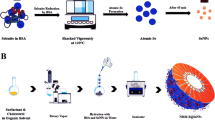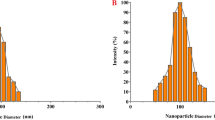Abstract
The anti-tumor effect of selenium nanoparticles (SeNPs) has received more and more attention. However, the clinical application of SeNPs is not optimistic due to the poor stability. To improve the stability of SeNPs, many polymers are used to modify the SeNPs. However, most of the polymers are not approved by FDA. It is significant to develop a SeNPs product with good stability for clinic application. Dextran 70,000 (T70) and poloxamer 188 (P188) are FDA-approved pharmaceutical injection excipients. In this study, we decorate SeNPs with T70 and P188 and assess the physicochemical characterization, storage stability, and anti-tumor activities of T70-SeNPs and P188-SeNPs. Transmission electron microscopy (TEM) shows that T70-SeNPs and P188-SeNPs are spherical particles with particle sizes of 110 nm and 60 nm respectively. Fourier-Transform Infrared Spectra (FT-IR) show that T70 or P188 can interact with SeNPs through hydrogen bonding. Stability study shows that P188-SeNPs freeze-dried powder and T70-SeNPs freeze-dried powder remain stable at 4℃ for 6 months. T70-SeNPs and P188-SeNPs can aggregate in cell matrix and play an anti-tumor role to HepG2 by promoting apoptosis, increasing reactive oxygen species (ROS) content and reducing mitochondrial membrane potential (MMP). This study can provide reference for industrial production of SeNPs products.
Graphical abstract







Similar content being viewed by others
References
Singh A, Settleman J. EMT, cancer stem cells and drug resistance: an emerging axis of evil in the war on cancer. Oncogene. 2018;29(34):4741–51.
Yu QD, Xiao XY, Wen LL, Jian W, Cheng ZH. A cancer-targeted drug delivery system developed with gold nanoparticle mediated DNA-doxorubicin conjugates. RSC Adv. 2014;4(66):34830–5.
Liu Q, Du J. Asymmetrical polymer vesicles for significantly improving MRI sensitivity and cancer-targeted drug delivery. Nanomed Nanotechnol Biol Med. 2016;12(2):483.
Wang S, Su R, Nie S, Sun M, Zhang J, Wu D, et al. Application of nanotechnology in improving bioavailability and bioactivity of diet-derived phytochemicals. J Nutr Biochem. 2014;25(4):363–76.
Davidovits P. Nanotechnology in biology and medicine. Physics in Biology and Medicine (Fifth Edition). 2019:293–305.
Lou J, Zhang L, Zheng G. Advancing cancer immunotherapies with nanotechnology. Advanced Therapeutics. 2019;35:1800128–58.
Yang L, Zhe R, Rb B, Xl A, Jz A, Ry C, et al. Designing selenium polysaccharides-based nanoparticles to improve immune activity of Hericium erinaceus - ScienceDirect. Int J Biol Macromol. 2020;143:393–400.
Xu C, Lu G, Li Q, Zhang J, Gao X. Selenium modulates MMP2 expression through the TGFβ1/Smad signalling pathway in human umbilical vein endothelial cells and rabbits following lipid disturbance. J Trace Elem Med Biol. 2017;42:59–67.
Kong H, Yang J, Zhang Y, Fang Y, Nishinari K, Phillips G. Synthesis and antioxidant properties of gum Arabic-stabilized selenium nanoparticles. Int J Biol Macromol. 2014;65:155–62.
Pang KL, Chin KY. Emerging anticancer potentials of selenium on osteosarcoma. Int J Mol Sci. 2019;20(21):5318–37.
Rayman MP. Selenium and human health. The Lancet. 2012;379(9822):1256–68.
Zhang J, Wang X, Xu T. Elemental selenium at nano size (Nano-Se) as a potential chemopreventive agent with reduced risk of selenium toxicity: comparison with se-methylselenocysteine in mice. Toxicol Sci. 2008;101(1):22–31.
Mal J, Veneman WJ, Nancharaiah YV, Hullebusch EV, Peijnenburg W, Vijver MG, et al. A comparison of fate and toxicity of selenite, biogenically, and chemically synthesized selenium nanoparticles to zebrafish (Danio rerio) embryogenesis. Nanotoxicology. 2017;11(1):87–97.
Maiyo F, Singh M. Selenium nanoparticles: potential in cancer gene and drug delivery. Nanomedicine. 2017;12(9):1075–89.
Gao X, Li X, Mu J, Ho CT, Xie Y. Preparation, physicochemical characterization, and anti-proliferation of selenium nanoparticles stabilized by Polyporus umbellatus polysaccharide. Int J Biol Macromol. 2020;152:605–15.
Sun D, Liu Y, Yu Q, Qin X, Jie L. Inhibition of tumor growth and vasculature and fluorescence imaging using functionalized ruthenium-thiol protected selenium nanoparticles. Biomaterials. 2014;35(5):1572–83.
Fang Y, Tang Q, Zhong X, Bai Y, Zheng W. Surface decoration by Spirulina polysaccharide enhances the cellular uptake and anticancer efficacy of selenium nanoparticles. Int J Nanomed. 2012;7:835–44.
Weiss J, Takhistov P, Mcclements DJ. Functional materials in food nanotechnology. J Food Sci. 2006;71(9):107–16.
Santiago PS, Carvalho F, Domingues MM, Carvalho J, Santos NC, Tabak M. Isoelectric point determination for Glossoscolex paulistus extracellular hemoglobin: oligomeric stability in acidic pH and relevance to Protein− surfactant interactions. Langmuir. 2010;26(12):9794–801.
Kumar S, Tomar MS, Acharya A. Carboxylic group-induced synthesis and characterization of selenium nanoparticles and its anti-tumor potential on Dalton’s lymphoma cells. Colloids Surf, B. 2015;126:546–52.
Guo M, Li Y, Lin Z, Zhao M, Xiao M, Wang C, et al. Surface decoration of selenium nanoparticles with curcumin induced HepG2 cell apoptosis through ROS mediated p53 and AKT signaling pathways. RSC Adv. 2017;7(83):52456–64.
Nie T, Wu H, Wong KH, Chen T. Facile synthesis of highly uniform selenium nanoparticles using glucose as the reductant and surface decorator to induce cancer cell apoptosis. Journal of Materials Chemistry B. 2016;4(13):2351–8.
Bulgarini A, Lampis S, Turner RJ, Vallini G. Biomolecular composition of capping layer and stability of biogenic selenium nanoparticles synthesized by five bacterial species. Microb Biotechnol. 2020;14(1):198–212.
Pamela K, Lidia, et al. Sulforaphane-conjugated selenium nanoparticles: towards a synergistic anticancer effect. Nanotechnology. 2019;30(6):65101–33.
Davidovich P, Kearney CJ, Martin SJ. Inflammatory outcomes of apoptosis, necrosis and necroptosis. Biol Chem. 2014;395(10):1163–71.
Peterson JW, Bö L, Mörk S, Chang A, Trapp BD. Transected neurites, apoptotic neurons, and reduced inflammation in cortical multiple sclerosis lesions. Ann Neurol. 2010;50(3):389–400.
Juncadella IJ, Kadl A, Sharma AK, Shim YM, Hochreiter-Hufford A, Borish L, et al. Apoptotic cell clearance by bronchial epithelial cells critically influences airway inflammation. Nature. 2013;493(7433):547–51.
Gray M, Miles K, Salter D, Gray D, Savill J. Apoptotic cells protect mice from autoimmune inflammation by the induction of regulatory B cells. Proc Natl Acad Sci USA. 2007;104(35):14080–5.
Chaudiere J, Courtin O, Leclaire J. Glutathione oxidase activity of selenocystamine: a mechanistic study. Arch Biochem Biophys. 1992;296(1):328–36.
Epp O, Ladenstein R, Wendel A. The refined structure of the selenoenzyme glutathione peroxidase at 0.2-nm resolution. Febs Journal. 2010;133(1):51–69.
Luan X, Yan Y, Zheng Q, Wang M, Fang J. Excessive reactive oxygen species induce apoptosis via the APPL1-Nrf2/HO-1 antioxidant signalling pathway in trophoblasts with missed abortion. Life Sci. 2020;254:117781–93.
Friedman JR, Nunnari J. Mitochondrial form and function. Nature. 2014;505(7483):335–43.
Wang Z, Guo W, Xiao K, Hou S, Liu H. Nanopreparations for mitochondria targeting drug delivery system: Current strategies and future prospective. Asian J Pharm Sci. 2017;12(6):498–508.
LiãΫE D, Wilkens V, You C, Busch P, Piehler P. Selective targeting of fluorescent nanoparticles to proteins inside live cells. Angewandte Chemie. 2011;50(40):9352–5.
Jia X, Liu Q, Zou S, Xu X, Zhang L. Construction of selenium nanoparticles/β-glucan composites for enhancement of the antitumor activity. Carbohyd Polym. 2015;117:434–42.
Funding
This work was supported by the National Natural Science Foundation of China (81803458).
Author information
Authors and Affiliations
Corresponding authors
Ethics declarations
Conflict of Interest
The authors declare no competing interests.
Additional information
Publisher's Note
Springer Nature remains neutral with regard to jurisdictional claims in published maps and institutional affiliations.
Rights and permissions
About this article
Cite this article
Wang, Z., Ji, L., Ren, Y. et al. Preparation and Anti-tumor Study of Dextran 70,000-Selenium Nanoparticles and Poloxamer 188-Selenium Nanoparticles. AAPS PharmSciTech 23, 29 (2022). https://doi.org/10.1208/s12249-021-02141-4
Received:
Accepted:
Published:
DOI: https://doi.org/10.1208/s12249-021-02141-4




